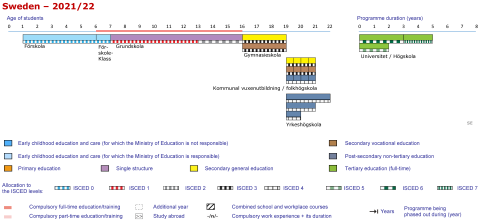Introduction
Sweden has a decentralised education system, steered by goals and learning outcomes defined at the central level. The government has the overall responsibility and sets the framework for education at all levels but municipalities are responsible for organising most of the education from preschool to upper secondary school as well as municipal adult education and Swedish tuition for immigrants.
The public school system for children and young people covers:
- The preschool (förskolan)
- The preschool class (förskoleklassen)
- Compulsory school (grundskolan)
- Upper secondary school (gymnasieskolan)
- Compulsory school for pupils with intellectual disabilities (anpassad grundskola)(anpassad gymnasieskola)
- Schools for pupils with impaired hearing (specialskolan)
- The Sami school (sameskolan)
The public school system for adults consists of:
- Municipal adult education (kommunal vuxenutbildning)
- Municipal adult education for adults with intellectual disabilities (komvux som anpassad utbildning)
- Swedish tuition for immigrants (sfi)
- Liberal adult education (folkbildning)
Higher education is conducted at universities and university colleges, where both types of institutions have equivalent status with regard to undergraduate education (first and second cycles).
Compulsory Education
The compulsory school system comprises compulsory school (grundskolan), the Sami school (sameskolan) for Sami-speaking children who live in the north of the country, schools for pupils with impaired hearing (specialskolan), and education for pupils with learning disabilities (grundsärskolan).
Municipalities are obliged to arrange preschool classes (förskoleklass) for all children six years of age. Participation in the preschool class is mandatory.
Under the Education Act, nine years of compulsory schooling is obligatory for all children aged 7 to 16, i.e. school attendance is compulsory. The Education Act also states that children and young people have a right to receive education in the national school system. Although most children start school in the year they turn seven, the start of compulsory schooling is flexible and the starting age can vary from six to eight according to the wish of the parents or guardian. Compulsory attendance at school lasts for nine years, regardless of starting age.
As of January 2002, the right to education includes children seeking asylum and children in similar circumstances. They are to have access to preschool activities, school-age childcare and education in the public education system on essentially the same conditions as children resident in Sweden.
A new Education Act (Skollagen) came into force by the autumn term of 2011. As a consequence, a new curriculum for the compulsory school system (Läroplan för grundskolan, förskoleklassen och fritidshemmet) applies as of autumn 2011. It covers the compulsory school (grundskola), the preschool class (förskoleklass) and leisure-time centres (fritidshem). In addition, there are new curricula for schools for pupils with impaired hearing (specialskola) and schools for pupils with learning disabilities (grundsärskola). In 1998, the preschool (förskola) received its first national curriculum, which was replaced in 2018 (Läroplan för förskolan).
Schools at the compulsory level are funded by municipal grants from the pupils' home municipalities and by state grants, i.e. are grant-aided, and free of charge, and this also includes school meals, tools and equipment and (when needed) transport. For more information on financing, see 3.1 - Funding.
Upper Secondary School
A new structure for the upper secondary school (gymnasieskolan) was introduced 1 July 2011. The previous 17 national programmes were replaced by 18 national programmes; 6 higher education preparatory programmes and 12 vocational programmes. The individual programme was replaced by five introductory programmes, individually adapted to the pupils. History was introduced as a new common core subject for all programmes.
All the upper secondary school programmes are designed around the same eight compulsory subjects, called core subjects: Swedish/Swedish as a second language, English, mathematics, civics, religion, science studies, physical education and health, and artistic activities. In addition to these, pupils study programme specific subjects.
Curriculum for the Upper Secondary School (Läroplan för gymnasieskola)
Curriculumn for the Upper Secondary School for pupils with intellectual disabilities (Läroplan för anpassade gymnasieskolan)
Curriculum for Adult Education and Education for Adults with Intellectual Impairments (Läroplan för vuxenutbildningen)
Tertiary Education
All higher education is pursued in courses and programmes. The courses can be taken separately or as part of a study programme to lead to degrees. The scale of a course or study programme is measured in 'credit points' in line with the ECTS. Full-time studies during one year equal 60 credit points. Higher education institutions (HEIs) decide about the organisation of their courses.
Mainly as a result of the Bologna process, legislation for a three-cycle structure of higher education was applied from July 2007. The new structure replaces the former system and is the only structure for all HEIs. This new system aims at improving international comparability of Swedish education, as intended by the Bologna process. A credit point system in line with ECTS is now mandatory, see 3.0 - Higher Education.
The Higher Education Ordinance, (Högskoleförordningen)
Adult Education
Adult education provided by municipalities consists of:
● Municipal adult education
● Municipal adult education for adults with intellectual disabilities
● Swedish tuition for immigrants
In addition, there is higher vocational education (yrkeshögskola), a post-secondary education and training program in which a part of the time often is spent at a workplace. Higher vocational education is organised by municipalities, educational companies and university colleges in conjunction with working life. In July 2009 the Swedish National Agency for Higher Vocational Education (Myndigheten för yrkeshögskolan) was established to develop and oversee a new form of publicly funded vocational education at post upper secondary level.
Higher Vocational Education Courses, HVECs, cover a wide range of vocational areas with one common goal, namely the provision of advanced vocational education, tailored to the needs of the labour market. In HVECs a modern approach is taken where theoretical learning is integrated and blended with vocational practice at the workplace. HVECs are needed as they are intended to serve the needs of job seekers and industries where competence and labour are in demand. For this reason companies and the business sector partner in the design and construction right from the very start. Content is jointly determined. HVECs last for at least six months and participant progress and outcomes are assessed and recognised by a certificate/diploma that validates their skills for employment.
The role of the Swedish National Agency for Higher Vocational Education is to set up a common framework agreed upon and followed by vocational education and training providers.
The liberal adult education sector (folkbildning) also provides adult education through folk high schools (folkhögskolor) and adult education associations (studieförbund). Some folk high school courses and some of the education within the supplementary education programmes and labour market training programmes are comparable to higher vocational education, in terms of content. A large part of higher education is also directed towards competence development and further training of adults.
The Swedish Public Employment Service (Arbetsförmedlingen) is responsible for the labour market training (arbetsmarknadsutbildning) intended primarily for unemployed adults in need of retraining or further training and education.
Stages of the Swedish Education System

source: Eurydice

